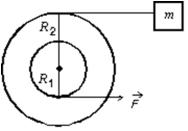Multiple Choice
A small disk of radius R1 is mounted coaxially with a larger disk of radius R2.The disks are securely fastened to each other and the combination is free to rotate on a fixed axle that is perpendicular to a horizontal frictionless table top, as shown in the overhead view below.The rotational inertia of the combination is I.A string is wrapped around the larger disk and attached to a block of mass m, on the table.Another string is wrapped around the smaller disk and is pulled with a force  as shown.The acceleration of the block is:
as shown.The acceleration of the block is: 
A) R1F/mR2
B) R1R2F/(I - mR22)
C) R1R2F/(I + mR22)
D) R1R2F/(I - mR1R2)
E) R1R2F/(I + mR1R2)
Correct Answer:

Verified
Correct Answer:
Verified
Q67: Two wheels are identical but wheel B
Q68: A circular saw is powered by a
Q69: If a wheel is turning at 3.0
Q70: The torque exerted on an object can
Q71: An object rotates from θ<sub>1</sub> to θ<sub>2</sub>
Q73: A solid uniform sphere of radius R
Q74: A disk has a rotational inertia of
Q75: A wheel initially has an angular velocity
Q76: An 8.0-cm radius disk with a rotational
Q77: One revolution per minute is about:<br>A)0.0524 rad/s<br>B)0.105